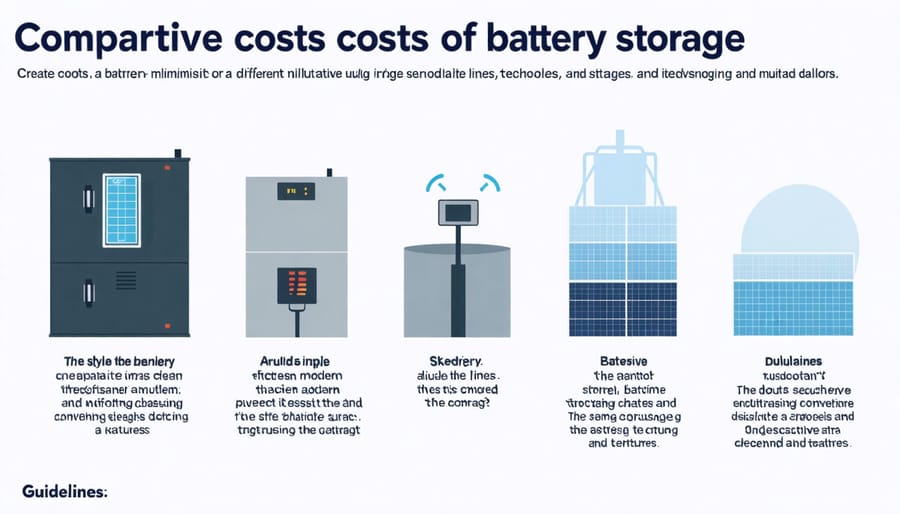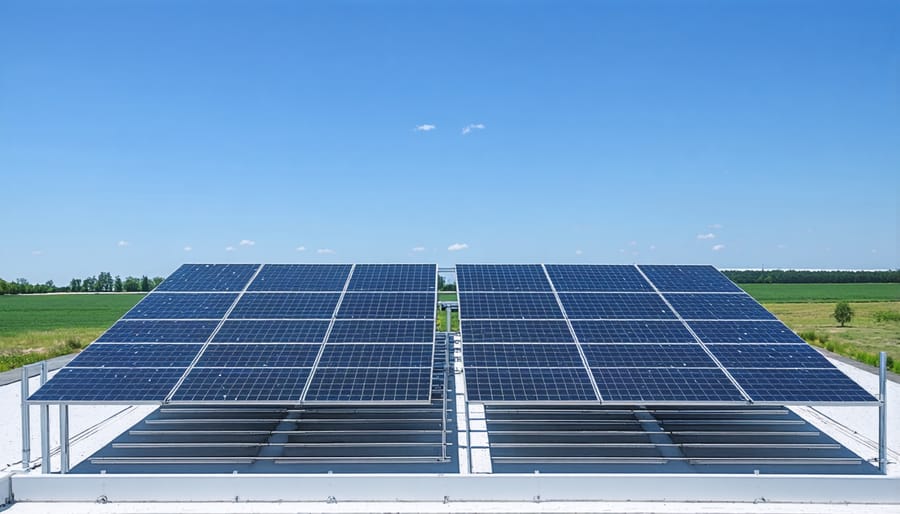Energy storage costs per kilowatt-hour have plummeted by 89% over the past decade, transforming the economics of renewable energy implementation and accelerating business returns from solar investment. Today’s lithium-ion battery systems average $132/kWh, with projections indicating a further 27% reduction by 2025. This dramatic price reduction, coupled with advancing technology and economies of scale, has positioned energy storage as a critical component for businesses seeking to optimize their energy expenditure and enhance grid independence.
For facility managers and business owners, understanding storage costs per kWh is essential for calculating ROI and developing effective energy management strategies. The total cost encompasses not just the battery units themselves, but also installation, maintenance, and system integration expenses. When properly implemented, modern storage solutions can reduce peak demand charges by up to 40% while providing crucial backup power capabilities, making them an increasingly viable option for organizations of all sizes.
Current Energy Storage Cost Breakdown
Initial Investment Costs
The initial investment costs for energy storage systems represent a significant portion of the total expenditure, requiring careful consideration of both equipment and installation components. Battery storage systems typically range from $400 to $750 per kWh of capacity, with larger commercial installations often benefiting from economies of scale. A comprehensive understanding of these hidden costs and benefits is crucial for accurate budgeting.
The primary equipment costs include:
– Battery modules: 40-50% of total system cost
– Inverters and power electronics: 15-20%
– Battery management systems: 10-15%
– Racking and containment systems: 5-10%
Installation costs typically account for 20-30% of the total investment and encompass:
– Site preparation and engineering
– Electrical work and grid connection
– Safety systems and monitoring equipment
– Permits and inspections
– System commissioning
For a typical commercial installation, labor costs average $100-150 per kWh of capacity. Additional considerations include transportation, warranty coverage, and potential utility interconnection fees. While these upfront costs may seem substantial, they have decreased significantly over the past decade, with further reductions expected as technology advances and manufacturing scales up.
Operational and Maintenance Expenses
Operational and maintenance expenses (O&M) constitute a significant portion of the total cost of energy storage systems over their lifetime. For lithium-ion battery systems, annual O&M costs typically range from $6 to $12 per kWh of storage capacity. These expenses primarily cover regular maintenance checks, component replacements, and system monitoring.
Preventive maintenance activities include periodic inspection of battery cells, testing of thermal management systems, and calibration of power electronics. Most modern systems require quarterly inspections and annual comprehensive maintenance, with labor costs averaging $1,500 to $3,000 per year for a medium-sized installation.
Software and monitoring systems, essential for optimal performance, typically cost between $0.5 and $1.5 per kWh annually. These systems help prevent degradation and extend battery life through smart management algorithms. Insurance costs, another crucial consideration, generally amount to 0.5% to 1% of the total system cost per year.
Component replacement represents a significant long-term expense. Battery modules may need replacement after 8-12 years, depending on usage patterns and environmental conditions. Planning for these replacements is essential, with costs potentially reaching 40% of the initial battery investment.
Facility managers can optimize O&M costs through preventive maintenance programs and performance monitoring. Many providers now offer service contracts that bundle maintenance, monitoring, and warranty coverage, providing predictable annual expenses and reducing unexpected costs.
Factors Influencing Storage Costs
Battery Technology Selection
The selection of battery technology significantly impacts the overall cost per kWh of energy storage systems. Lithium-ion batteries currently dominate the market, offering costs between $200-$300 per kWh, down from over $1,000 per kWh a decade ago. This dramatic price reduction has made energy storage increasingly viable for commercial applications.
Flow batteries, while initially more expensive at $400-$600 per kWh, offer advantages in longer-duration storage and lower degradation rates over time. Their ability to separate power and energy capabilities makes them particularly suitable for large-scale industrial applications requiring extended discharge periods.
Lead-acid batteries remain the most economical option at $150-$200 per kWh, but their shorter lifespan and lower energy density often result in higher long-term costs. They’re typically best suited for backup power systems with infrequent use.
Emerging technologies like sodium-ion and zinc-air batteries show promise in reducing costs further, with projected prices below $100 per kWh by 2025. These alternatives may offer more sustainable and cost-effective solutions, particularly in regions where lithium availability is limited.
When selecting battery technology, organizations must consider:
– Initial capital costs
– Cycle life and degradation rates
– Operating temperature requirements
– Maintenance needs
– Space constraints
– Safety considerations
– Environmental impact
The optimal choice depends on specific application requirements, with some facilities benefiting from hybrid systems that combine different battery technologies to balance cost and performance. Regular assessment of new battery technologies entering the market can help organizations optimize their energy storage investments as the technology continues to evolve and improve.

System Size and Scale
The economics of energy storage systems demonstrate a clear correlation between system size and cost per kilowatt-hour (kWh). Larger systems typically benefit from economies of scale, resulting in lower per-unit costs. For commercial installations above 100 kWh, costs can decrease by 15-25% compared to smaller residential systems, primarily due to bulk purchasing power and optimized installation efficiency.
When evaluating system capacity, it’s essential to consider both initial capital costs and long-term operational expenses. While kWh energy production factors vary by location and usage patterns, larger systems generally offer better return on investment through reduced per-unit maintenance costs and enhanced operational efficiency.
For example, a 500 kWh commercial system might cost $400-450 per kWh, while a 50 kWh residential system could range from $500-600 per kWh. This pricing differential becomes particularly significant when factoring in installation costs, which don’t scale linearly with system size. Industrial-scale systems exceeding 1 MWh can achieve even lower costs, sometimes reaching $350 per kWh or less.
However, optimal sizing requires careful analysis of actual energy demands. Over-sizing can lead to unnecessary capital expenditure and reduced system efficiency, while under-sizing may result in inadequate storage capacity and missed opportunities for peak load management. Organizations should conduct detailed load profiling and future growth projections before determining their ideal storage capacity to maximize cost-effectiveness and operational benefits.


ROI and Cost Recovery Analysis
Energy Bill Reduction
Energy storage systems play a crucial role in reducing electricity bills through strategic peak demand management. By storing energy during off-peak hours when rates are lower and utilizing it during peak periods when costs are higher, businesses can significantly optimize their energy expenses. This practice, known as peak shaving, can lead to substantial savings while providing energy independence benefits for organizations.
A typical commercial facility can reduce its peak demand charges by 20-30% through properly sized energy storage systems. For example, a manufacturing plant implementing a 500kWh storage system might save $50,000-$75,000 annually on demand charges alone. These savings are achieved by automatically switching to stored energy when grid consumption approaches peak threshold levels.
The effectiveness of peak demand management depends on several factors, including:
– Local utility rate structures
– Peak demand window timing
– Facility load profile
– Storage system capacity
– Energy management software capabilities
Many utilities offer demand response programs that provide additional revenue streams for businesses with energy storage systems. By participating in these programs, organizations can earn incentives for reducing their grid consumption during high-demand periods, further enhancing the financial benefits of their storage investment.
To maximize cost reduction potential, facilities should conduct detailed load analysis and work with experienced energy consultants to determine optimal storage capacity and control strategies.
Government Incentives
Government incentives significantly reduce the effective cost of energy storage systems, making them more financially attractive for businesses and organizations. The federal Investment Tax Credit (ITC) offers a 30% tax credit for battery storage systems charged by renewable energy sources, substantially lowering initial investment costs. This credit applies to both commercial and industrial installations, with no maximum cap on system size.
Several states offer additional incentives, such as California’s Self-Generation Incentive Program (SGIP), which provides rebates up to $200 per kilowatt-hour for energy storage systems. Massachusetts’ SMART program offers enhanced incentives for solar-plus-storage installations, while New York’s NY-Sun program provides per-kilowatt-hour incentives for qualified storage projects.
Many utility companies also offer demand response programs that provide recurring revenue streams for businesses with energy storage systems. These programs typically offer payments for reducing grid demand during peak periods, effectively improving the ROI of storage installations.
For businesses considering energy storage, it’s crucial to consult with qualified tax professionals and energy consultants to maximize available incentives. Some programs have limited funding or specific enrollment periods, so timing applications strategically is essential. Additionally, many state and local governments offer property tax exemptions and expedited permitting processes for energy storage installations, further reducing overall project costs and implementation timelines.
Cost Optimization Strategies
To maximize the cost efficiency of energy storage systems, organizations can implement several proven strategies. First, proper system sizing is crucial – oversizing leads to unnecessary capital expenditure, while undersizing may not meet energy demands effectively. Consider conducting detailed load analysis and energy consumption patterns before making investment decisions.
Implementing smart energy management systems can significantly reduce operational costs. These systems optimize charging and discharging cycles based on electricity rates and demand patterns, potentially saving 15-20% on energy costs. Regular maintenance and monitoring ensure optimal performance and extend battery life, ultimately reducing the cost per kWh over time.
Hybrid storage solutions often prove more cost-effective than single-technology systems. Combining different storage technologies, such as lithium-ion batteries with flow batteries, allows organizations to leverage the advantages of each technology while minimizing their respective drawbacks. For example, a manufacturing facility in California reduced its storage costs by 25% by implementing a hybrid system.
Taking advantage of government incentives and tax credits can substantially reduce initial investment costs. Many jurisdictions offer programs that can offset 20-30% of storage system costs. Additionally, participating in demand response programs and grid services can generate additional revenue streams, improving the overall ROI.
Temperature management is another critical factor. Maintaining optimal operating temperatures (typically between 20-25°C) can extend battery life by up to 40% and improve efficiency. Installing proper thermal management systems, while initially costly, pays dividends through reduced replacement costs and improved performance.
Bulk purchasing and strategic timing of procurement can lead to significant savings. Many manufacturers offer volume discounts, and prices tend to be more competitive during off-peak seasons. Organizations should also consider entering into long-term service agreements with providers to secure better rates for maintenance and replacements.
By implementing these strategies comprehensively, organizations can potentially reduce their energy storage costs by 30-40% over the system’s lifetime while maintaining optimal performance and reliability.
Energy storage costs have shown a remarkable downward trajectory over the past decade, with lithium-ion battery prices falling by more than 80% since 2010. This trend is expected to continue, with industry analysts projecting costs to decrease by an additional 40-60% by 2030. The current average cost range of $200-300 per kWh is anticipated to drop below $100 per kWh within the next five years, making energy storage increasingly accessible for businesses and organizations.
The future of energy storage economics looks promising, driven by technological advancements, manufacturing scale improvements, and growing market competition. As the industry matures, we’re seeing enhanced battery efficiency, longer lifespans, and better performance metrics, all contributing to improved return on investment for storage systems.
For decision-makers considering energy storage implementation, the key takeaway is that while current costs may seem substantial, the combination of declining prices, increasing energy costs, and growing grid instability makes storage systems an increasingly attractive investment. Organizations that begin planning and implementing storage solutions now will be better positioned to capitalize on future cost reductions and technological improvements.
Success in energy storage deployment will depend on careful system sizing, strategic timing of installation, and optimization of operating parameters. By staying informed about market trends and working with experienced providers, organizations can develop storage solutions that deliver both immediate and long-term value while supporting their sustainability goals.

